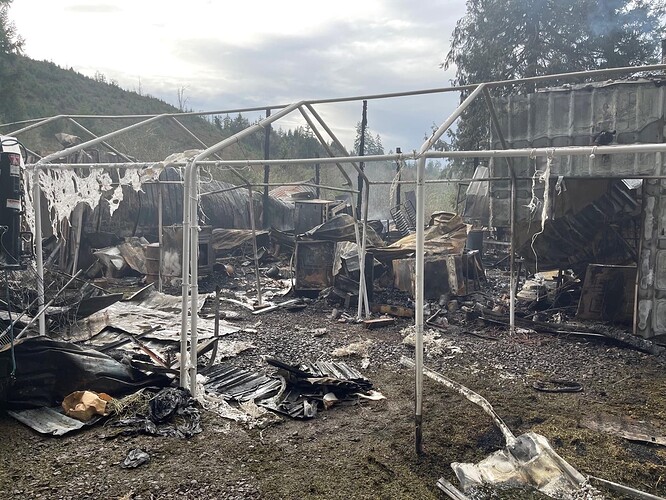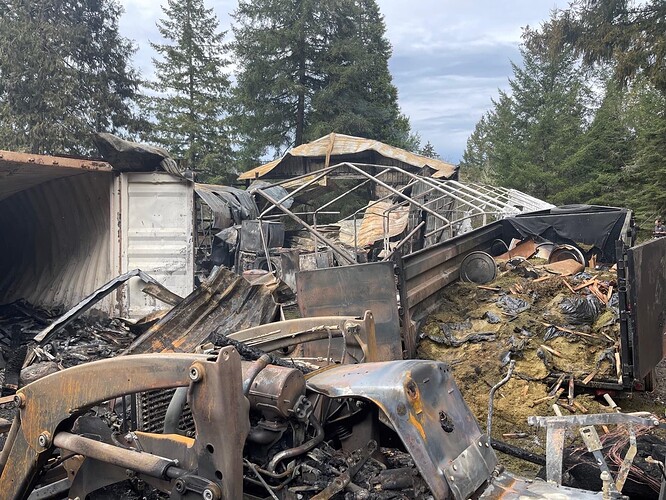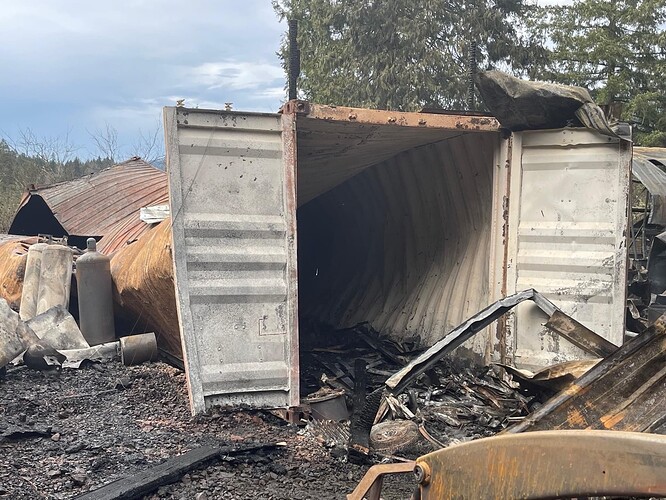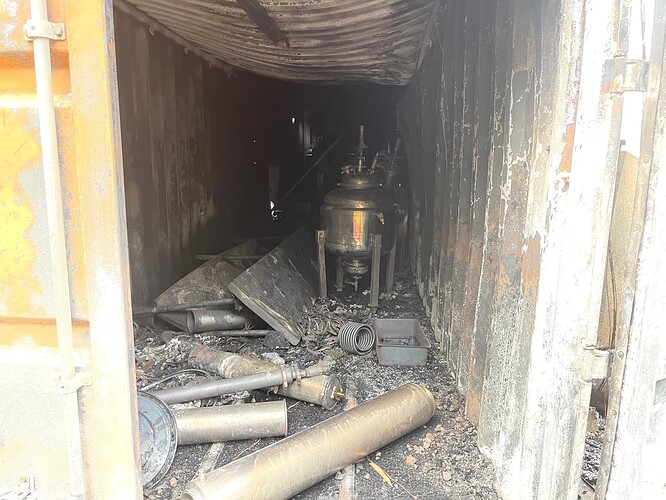When i was in welding school the teacher cracked a valve on 90# tank to show us how damaging they are even when not ignited and them filled a garbage bag with acetylene and let it float away before lighting it and it was a sonic boom from such a small amount of gas.
Fuel Gas “Lower Explosive or Flammable Limit”
(LEL/LFL)
(% by volume of air) “Upper Explosive or Flammable Limit”
(UEL/UFL)
(% by volume of air)
Acetaldehyde 4 60
Acetic acid 4 19.9
Acetone 2.6 12.8
Acetonitrile 3 16
Acetyl chloride 7.3 19
Acetylene 2.5 100
Acrolein 2.8 31
Acrylic acid 2.4 8
Acrylonitrile 3.0 17
Allyl chloride 2.9 11.1
Allyll alcohol 2.5 18
Alyllamine 2.2 22
Ammonia 15 28
Aniline 1.3 11
Arsine 5.1 78
Benzene 1.2 7.8
Biphenyl 0.6 5.8
Bromobuthane (1-Bromobuthane) 2.6 6.6
Bromoethane 6.8 8
Bromoethene 9 15
Butadiene (1,3-Butadiene) 2.0 12
Butanal 1.9 12.5
Butane (n-Butane) 1.86 8.41
Butanoic acid 2 10
Butyl acetate 1.7 7.6
Butyl alcohol, Butanol 1 11
Butyl formate 1.7 8.2
Butyl methyl ketone 1 8
Butylamine 1.7 9.8
Butylbenzene 0.5 5.8
Butylene 1.98 9.65
Butyll acrylate 1.9 9.9
Carbon disulfide 1.3 50
Carbon monoxide 12 75
Carbon oxysulfide 12 29
Chlorobenzene 1.3 9.6
Chloroethane 3.8 15.4
Cyanogen 6.0 42.6
Cyclobutane 1.8 11.1
Cycloheptane 1.1 6.7
Cyclohexane 1.3 8
Cyclohexanol 1 9
Cyclohexanone 1 9
Cyclopropane 2.4 10.4
Decane 0.8 5.4
Diacetone alcohol 1.8 6.9
Diborane 0.8 88
Dibutylamine 1.1 6
Dichloroethane (1,1-Dichloroethane) 6 11
Diesel fuel 0.6 7.5
Diethanolamine 2 13
Diethyl ether 1.9 36
Diethylamine 2 13
Diethylether 1.9 48
Diisobutyl ketone 1 6
Diisopropyl ether 1 21
Dimethyl sulphoxide 3 42
Epichlorohydrin 4 21
Ethane 3 12.4
Ethyl acetate 2 12
Ethyl acrylate 1.4 14
Ethyl alcohol, Ethanol 3.3 19
Ethyl chloride 3.8 15.4
Ethyl nitrite 4 50
Ethyl propyl ether 1.7 9
Ethyl vinyl ether 1.7 28
Ethylamine 3.5 14
Ethylbenzene 1.0 7.1
Ethylcyclobutane 1.2 7.7
Ethylene 2.75 28.6
Ethylene oxide 3 100
Etylene glycol 3 22
Fluoroethene 2.6 21.7
Formaldehyde 7 73
Formic acid 18 57
Fuel Oil - No.1 0.7 5
Furan 2 14
Furfural 2 19
Gasoline 1.4 7.6
Glycerol 3 19
Heptane 1.0 6.7
Heptane (n-Heptane) 1.0 6.0
Hexane 1.1 7.5
Hexane (n-Hexane) 1.25 7.0
Hydrazine 5 100
Hydrogen 4 75
Hydrogen 6 40
Hydrogen sulfide 4.3 46
Isobutanal 1.6 10.6
Isobutane 1.80 8.44
Isobutene 1.8 9.0
Isobutyl alcohol 2 11
Isooctane 0.79 5.94
Isopentane 1.32 9.16
Isophorone 1 4
Isopropyl alcohol, Isopropanol 2 12
Isopropylbenzene 0.9 6.5
Kerosene Jet A-1 0.7 5
Mesityl oxide 1.4 7.2
Methacrylic acid 1.6 8.8
Methane 4.4 16.4
Methylamine 4.9 20.7
Methyl acetate 3 16
Methyl alcohol, Methanol 6.7 36
Methyl acrylate 2.8 25
Methyl chloride 10.7 17.4
Methyl ethyl Ketone 1.8 10
Methyl formate 4.5 23
Methylhydrazine 2.5 92
Methyl isocyanate 5.3 26
Mineral spirits 0.7 6.5
Naphtalene 0.9 5.9
Naphthalene 0.9 5.9
Neohexane 1.19 7.58
Neopentane 1.38 7.22
Nitrobenzene 2 9
Nitroethane 3.4 17
Nitromethane 7.3 22.2
Nonane 0.8 2.9
Octane (n-Octane) 1.0 7
Oxirane 3 100
Paraformaldehyde 7 73
Pentane (n-Pentane) 1.4 7.8
Pentene (n-Pentene) 1.65 7.7
Pentyl acetat 1.1 7.5
Pentylamine 2.2 22
Phenol 1.8 8.6
Piperidine 1 10
Propane 2.1 10.1
Propanoic acid 2.9 12.1
Propene 2 11.1
Propyl acetate 2 8
Propylamine 2 10.4
Propylbenzene 0.8 6
Propyl nitrate 2 100
Propylene 2.0 11.1
Propylene oxide 2.3 36
Propyne 2.1 12.5
Pyridine 2 12
Silane 1.5 98
Styrene 1.1 6.1
Tetrafluoroethene 10 50
Tetrahydrofuran 2 12
Toluene 1.1 7.1
Trichloroethylene 13 90
Triethylene glycol 0.9 9.2
Triptane 1.08 6.69
Trimethylamine 2 11.6
Turpentine 0.8
Vinyl acetate 2.6 13.4
Vinyl butanoate 1.4 8.8
Vinyl chloride 3.6 33
o-Xylene 0.9 6.7
m-Xylene 1.1 7
p-Xylene 1.1 7
Very interesting as I didnt know there were some chemicals that do not require any oxygen to explode. Acetylene looks to be one of those. Any one that has a uel of 100 looks super dangerous. Im guessing the bigger the range the more dangerous it could be. The one thing these numbers dont take into effect is the ease at which these will ignite. Some things are just easier to ignite then others. Im guessing the flash point is what effects the ease of ignition.
Acetylene will explode from pressure, not just combust, which is why it has an upper range Of 100 (fully saturated). In the absence of oxygen, it can create an explosive pressure wave and heat during decomposition of the molecule.
Not necessarily. It is an air velocity measurement and you can’t calculate air exchanges without surface area of the exhaust vent factored in.
I thought linear feet per min was quite literally how fast that column of air needs to move from one end to the other.
Educate me sir!
Let’s use these dimensions.
18’L x 12’W x 12’H
I’m pretty sure it is a velocity measurement across the exhaust plane. So if you’re room of whatever size has a exhaust intake of 4’x10’ you would need 100 linear feet/minute velocity air being pulled through that size plane. Someone correct me if I’m wrong because it seems like a stupid measurement to me but that’s how it got calculated at our spot.
I wish i could find our velocity air test, we had it done in all 4 rooms and it was pretty neat to see.
I had the understanding that the column of air was the height x width at 100 linear ft /min
So my room is 12’h x 12’w and 18’ long.
So I’d need 144 cubic ft x 100 ft/ min
100/18 5.55 air exchanges a min or 14400 cfm
That air exchange would only happen during an emergency, I think normal operating cfm could be 10-15% of the 14400.
A little bird told me that 5600 CFM will get you your necessary velocities in a standard 20 or 40 foot conex in a wind tunnel configuration.
The trick is that you don’t need 100 ft/min through the whole container, only 18" above the floor and around equipment (if you’re working with a heavier-than-air vapor).
Just remember if the shit hits the fan, the only proper use for a fire extinguisher in a C1D1 environment is to clear a path to GTFO
If the rise is really significant, the most likely explanation is glowies doing this with directed energy, for whatever reason. (Maybe to regulate the market in their interest, only poisoned drugs allowed)
Any time the discussion involves UEL, the answer is GTFO. Sooner or later the flammable material in the atmosphere is going to drop into the explosive range.
In the spec gas business we only make blends to 50% LEL, just to be safe.
Since we’re on the topic of explosions, there is a specific name for a liquid propane explosion; a BLEVE. Boiling Liquid Expanding Vapor Explosion. If a propane tank is in a fire and ruptures, the immediate fumes coming off the liquid will be too rich you burn. The fumes keep expanding until they get below the UEL, then K A B O O M ! An explosion that will level everything anywhere near the tank.
YouTube bleve explosion of 100 pound propane tank.
Even worse: Road Tanker Bleve
Yeah, don’t worry… We’re still not buying your gas
The thread is about explosions and others wrote about LEL’s and UEL’s. Wasn’t trying to do anything but share relevant information with examples. It sure wasn’t a sales pitch.
I just felt like saying Dude. Get over it
Not confirmed a lab, probably not a lab due to being a storage space but it looks like there’s some sort of accelerant in there based on the severity and length of the fire
Not really, not over here in Hawaii! We haven’t seen any of that ‘smash & grab’ crap either have you?
“Police say butane caused explosion that injured Auburn man - CentralMaine.com” Butane exploded during drug processing, injured Auburn man and made home uninhabitable - CentralMaine.com
In theory 1 liter of liquid n-butane @ boiling point expands to 233 liters of n-butane vapor.
1 liter is equivalent to .0353 cubic feet
233 liters is equivalent to 8.23 cubic feet.
If you have 1 liter of liquid n-butane in a 10’ x 10’ x 10’ (1000 cubic ft) and the butane is allowed to completely evaporate in said area with no air exchange, the concentration of butane vapors would be .0823%, or just under half of the lower explosive limit.
Like @mitokid said, if your concentration is at 8.4% (upper explosive limit) n-butane vapors in the atmosphere, something is SERIOUSLY wrong. That would equate to 10L of liquid n-butane expanding to 8.23% atmosphere in a 10’ x 10’ x 10’ room with no air exchange.
It only would take 2 liters of liquid n-butane expanding completely to vapor to surpass the the lower explosive limit given the same parameters.
Keep in mind that this ratio is extremely easy to achieve if you are not working in an area with sufficient airflow.
If you have room temp vessel leaking and say a gasket fails, it will not take long to evaporate 2 liters of butane in a 1000 cubic ft room, creating a very dangerous environment.
This is all theory. In reality the concentration of butane can and will be higher or lower depending on where the source of the butane vapor is and how fresh airflow is moving over it.
For example, a mason jar with a butane rich solution can and will most likely be constantly off gassing n-butane thru the lid. Somewhere (maybe right next to the lid, or on the floor of the room the jar is off gassing in, or other places) can be withen the explosive limits of n-butane. If there is an ignition source, n-butane will go boom.
Be safe my friends



